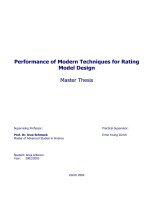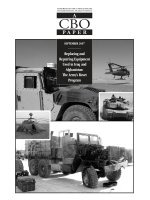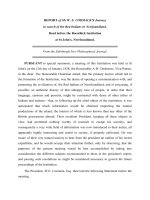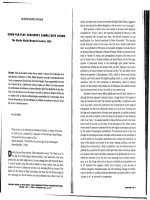Modern Cartooning: Essential Techniques for Drawing Today''s Popular Cartoons
Bạn đang xem bản rút gọn của tài liệu. Xem và tải ngay bản đầy đủ của tài liệu tại đây (9.66 MB, 597 trang )
Copyright © 2013 by Cartoon Craft LLC
All rights reserved.
Published in the United States by Watson-Guptill Publications, an imprint
of the Crown Publishing Group, a division of Random House, Inc., New
York.
www.crownpublishing.com
www.watsonguptill.com
WATSON-GUPTILL and the WG and Horse designs are registered
trademarks of Random House, Inc.
Library of Congress Cataloging-in-Publication Data
Hart, Christopher
Modern cartooning: essential techniques for drawing today’s popular
cartoons / Christopher Hart. — First Edition.
Includes index.
1. Cartoon characters. 2. Cartooning—Technique. I. Title.
NC1764.H377 2013
741.51—dc23
2012013977
eISBN: 978-0-8230-0715-8
Book design by M.80 Design
Covert art by Christopher Hart
v3.1
DEDICATED TO ALL ASPIRING
CARTOONISTS EVERYWHERE!
Cover
Title Page
Copyright
Dedication
INTRODUCTION
BASIC HEAD SHAPE
The Circle
FACIAL FEATURES
The Eyes
The Nose
Problem
The Mouth
The Eyes and
Mouth
Working
Together
MOVING
BEYOND
THE BASIC
HEAD
SHAPE
Small Changes—Big Results
The Classic Cartoon Head Shape
Sculpting the Head Shape
Character Sketching
Adding Extreme Visual Effects
MEDIUM SHOTS: THE BEST, MOST
OVERLOOKED ANGLE
Pretty Teen with Funny Hat
Sporty Athlete
First Snowflake
THE
UNIVERSAL
BODY TYPE
Standard Cartoon
Body Type
Rubbery Torso
Building the Total
Figure from a
Single Shape
Using Clothing to
Define Body
Shapes
Drawing the
Female Body: Teens through Adults
Basic Construction on a Real Finished Cartoon
PUTTING YOUR CHARACTERS
TOGETHER
Can Never Have Enough Shoes
Funny Stance
Merry Christmas to Me!
Enhancing an Existing Drawing
DIFFERENT BODY TYPES
Dorky Dad
1950s Mom
Trailer Mom
Funny Senior
Mr. Bench Press
ADDING IMPORTANT DETAILS
The Line of Action
Stretching and Condensing the Body
SAVING THE BEST FOR LAST: STUFF YOU
WON’T LEARN IN ART SCHOOL
The Fine Points
Drawing the Characters in Their Own Scenes
INDEX
This is the first cartooning book specifically
designed for the person who has never
drawn cartoons before. With carefully
crafted, clear step-by-step drawings and an
amazing abundance of hints and tips, you’ll
gain the confidence and skill needed to
draw cartoons the way you’ve always
wanted to.
I’ll show you how to draw great-looking
characters right away. The trick is to learn
how to draw the basic head shapes and
apply facial features from a wide selection
of the most popular types in cartooning
today. You’ll start with a circle, then
discover new shapes. I’ll show you how to
mold the head into new and unique shapes
to convey humorous and highly entertaining
attitudes.
For this book, I created the “Universal
Body Shape.” I’ll also show you how to use a
basic rectangle to create the foundation for
just about every type of character. How
easy is that?
You’ll learn all of these secrets and more.
I’ll also show you how to take established
art techniques and tweak them to create
humorous and often clueless cartoon
characters. You’ll amaze your friends. You’ll
crush your enemies. Hey, how many
cartooning books can promise all that?
Welcome to the world of cartooning. The
chapters ahead are funny, cute, and crazy.
So take out your pencil. Wait. That was a
little slow. Try it again. Okay, ready? Now!
Oh, almost! Oh, what the heck, let’s get
started.
cartooning from a contextual standpoint. Just
kidding! Let’s just start drawing instead!
You may wonder if it’s possible to create
stylish and contemporary cartoons by
beginning at a basic level. You foolish,
foolish mortal. The faces you’re going to
begin with are easy to draw, but they’re also
character designs of a high level that are
entertaining and stuffed with personality.
You can achieve these results by the creative
use of a few simple head shapes, combined
with the right types of facial features. But
there’s more to it than that. My approach to
cartooning stresses the construction of the
head shape (in this case, a circle). Head
shapes should remain conspicuous, even in
the final character design. This technique
causes the outline of the head to appear as a
primary feature of your cartoon character,
like cartoon eyes or noses. The basic head
construction does not just serve as a
guideline for the finished drawing; it
becomes a caricature of a “regular” head.
It used to be that the initial foundation of
the head was there to simply get the
drawing started, and was later forgotten.
Oh, how young and innocent cartoonists
were back then! But enough of this forced
walk down memory lane—let’s get started!
Many cartoonists start cartoons with a
circle, but then modify it at their first
opportunity. Why? The circle is a pleasing
shape. Roundness is an appealing element
in many character designs. But the
simplicity of the circle can also become a
liability. The circle is such a common shape
that it does not always command the
viewer’s attention.
But you can create excitement for your
circle-based characters by making them so
simplistic and round that they look
amusingly absurd. And you don’t have to
start with a perfect circle! A sloppy hand-
drawn circle is fine. You won’t get a bad
grade for not doing everything perfectly. At
least, not a really bad grade.
The circle works best for boys, girls, and
female teen characters. You can also create
older characters with this starting point, but
it takes more inventiveness to pull it off.
Circles tend to make everyone look young.
MISCHIEVOUS KID
Here’s a cute kid with mpd (mischievous
personality disorder). Please don’t leave any
weapons-grade nuclear material near him—
just to be extra cautious. You don’t want to
know what almost happened last time
someone forgot to put away the plutonium.
Draw a circle—any circle—neat, sloppy, lopsided, it
doesn’t matter.
Divide the head in half with the center line.
Place the eye line low across the head, and use guidelines
to keep the eyes evenly aligned.
Concentrate the features snuggly at the guidelines’
crossroads.
Place the ears low on the head, keeping them aligned on
the same level. Cut the eyes off at the top for a
mischievous look.
Add wacky hair, way off to one side
Use an arching guideline to keep points of the ruffled hair
even.









